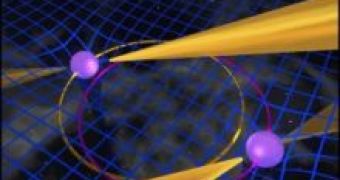Einstein's theory of general relativity has passed one of the most precise tests to date: astronomers observing a pair of pulsars orbiting each other determined that the theory is accurate within 0.05%. They have also obtained indirect evidence that gravitational waves exist - one of the most eluding predictions made by the general theory of relativity.
Professor Michael Kramer of the University of Manchester's Jodrell Bank Observatory, UK, is leading an international team that has been observing the double-pulsar system since 2003 with three of the world's largest radio telescopes: CSIRO's Parkes radio telescope in NSW, Australia; the Lovell Telescope near Manchester, UK; and the Robert C. Byrd Green Bank Telescope in West Virginia, USA.
Pulsars are rotating neutron stars that emit intermittent electromagnetic pulses like some cosmic lighthouses. The neutron stars are extremely dense and heavy stars that remain after a supernova explosion. They form when the initial star is not sufficiently large to leave behind a black hole - in case of the neutron stars, the gravitation of the star is balanced by the nuclear forces between neutrons, while in case of black holes, the gravitation is so large that it overwhelms the nuclear forces and the star collapses ad infinitum (or at least there is no known force that could stop the collapse).
The double-pulsar system observed by Kramer's team is the only known system of radio pulsars orbiting each other. It lies 2000 light-years away in the direction of the constellation Puppis. Each star weighs more than our own Sun but they are only about 20 km across. They orbit each other every 2.4 hours at speeds of a million kilometers per hour and are separated by a distance of just a million kilometers.
The two stars produce their lighthouse-like pulses every time their beams sweep past Earth. The timing of the pulses is normally very precise. However, because the neutron stars are very heavy and close to one another, there are measurable gravitational effects that influence the timing of the pulses. Astronomers managed to measure the small variations in pulse arrival times and to compare them to Einstein's predictions.
"This is the most stringent test ever made of general relativity in the presence of very strong gravitational fields - only black holes show stronger gravitational effects, but they are obviously much more difficult to observe," Professor Kramer says.
What happens
The masses of the neutron stars produce a strong distortion of space-time. In particular, when the stars are closer to each other, their "clocks" appear to go slower. As a consequence, we observe this variation of the timing of the pulses. Another consequence is the gravitational redshift - the fact that the light changes its color slightly because of the distortions of space-time: the color is due to the wavelength of light and as the space is distorted, the wavelength is also distorted.
Einstein's theory also predicts that the pulsars should emit gravitational waves and therefore, the system should lose energy. The consequence of this loss of energy is that the stars get closer and closer to each other. Astronomers have observed that the distance between the stars is shrinking by 7 mm a day.
"These [gravitational] waves have yet to be directly detected," says team member Prof. Dick Manchester of CSIRO's Australia Telescope National Facility ATNF). "But, as a result, the double pulsar system should lose energy causing the two neutron stars to spiral in towards each other by precisely the amount that we have observed - thus our observations give an indirect proof of the existence of gravitational waves."
The astronomers hope to make even more precise measurements of this system, in particular measurements regarding the rotation of the stars. There are some indications that the general theory of relativity may have problems at dealing with rotation. Such measurements might also offer more clues about the composition of the neutron stars.
"This measurement may be very difficult but if we could do it to just a precision of 30 per cent, we could distinguish between the many different ideas about the nature of the matter that makes up neutron stars," says team member Dr George Hobbs of the ATNF.

 14 DAY TRIAL //
14 DAY TRIAL //